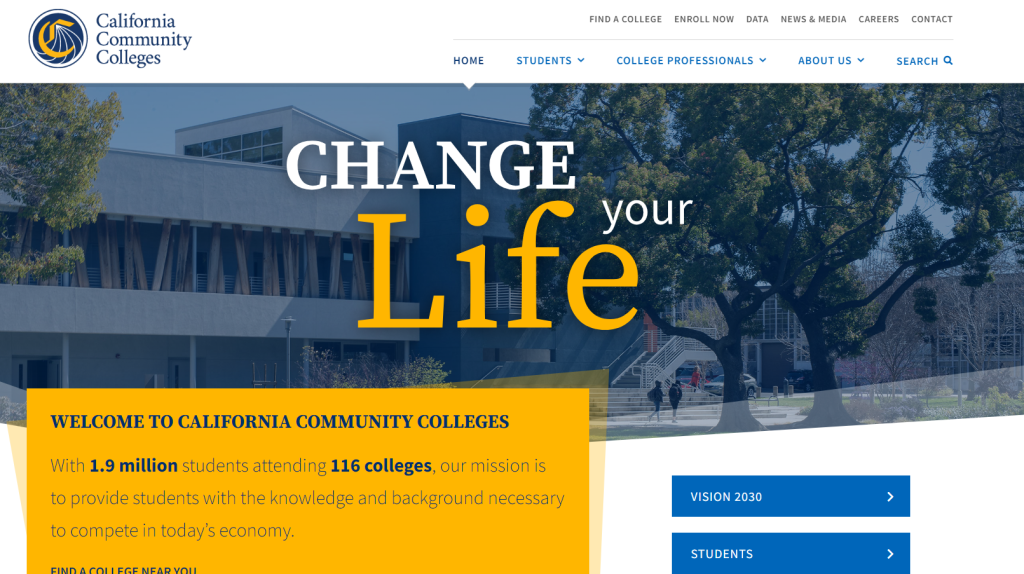Is community college free in California?
The rising cost of college can crush your dreams of higher education, especially in big cities like California. For an affordable degree alternative, the solution could be free community college!
To help you get answers to your questions, I have covered everything from eligibility to the application process, the benefits of the degree, and much more!
If you wish to learn how to pursue your educational goals without breaking the bank account– scroll down to learn more!
Key Takeaways
- California’s initiatives can cover community college tuition for eligible students.
- Criteria for tuition coverage include first-time enrollment, full-time status, and income level.
- Additional financial aid is available for non-tuition-related educational expenses.
Eligibility Requirements For Free Community College In California
To access free community college in California, students must meet specific eligibility criteria, primarily determined by the California College Promise Grant and various College Promise programs across the state, as well as particular income and residency requirements.
California College Promise Grant
The California College Promise Grant is instrumental in enabling students to have their enrollment fees waived. To qualify, one must apply and demonstrate financial need. The grant is designed for low-income students but does not necessarily cover other expenses such as textbooks or living costs.

California College Promise Programs
California College Promise Programs differ slightly by institution but commonly offer two years of tuition-free community college to first-time, full-time students.
Each community college may have additional criteria for its specific Promise programs, which could involve maintaining a certain GPA or participating in counseling.
Income Criteria
For most of these financial aid options, students’ income levels must fall within certain limits. The California College Promise Grant, for instance, requires applicants to display financial needs based on state-determined income ceilings.
Residency Criteria
Regarding residency, applicants must be California residents or qualify under AB 540 as a non-resident tuition exemption. Further, students must be attending full-time, which typically means enrolling in at least 12 credit hours per semester.
Application Process For Free Tuition
Securing free tuition through the California College Promise Program is an opportunity for eligible students to attend community college without the burden of tuition costs. The process requires strict adherence to application deadlines and providing the necessary documentation.
Application Deadlines
- Initial Deadline: Ensure early submission as spaces fill quickly.
- Secondary Deadlines: Some colleges may have later dates, but it’s prudent to apply as soon as possible.
Important dates can vary by institution, so it’s crucial to check the specific community college’s website or contact their financial aid office for accurate information.
Required Documentation
- Proof of Residency: Documentation demonstrating California residency is mandatory.
- Academic Records: Submission of high school transcripts or equivalent is typically required.
- Income Verification: If applicable, financial documentation may be needed for income-based qualifications.
Gather all necessary documentation well in advance of applying, and ensure that copies are clearly legible and accurate records of your eligibility for the program.
California Community Colleges Covered
California’s commitment to education is evident through programs like the California College Promise Program, which aims to make two years of community college tuition-free for first-time, full-time students.

However, it’s important to note that not all community colleges participate in this initiative, and eligibility requirements may vary.
List Of Eligible Colleges
The list of California community colleges that participate in the tuition-free program is extensive. To provide clarity, here is a breakdown of some colleges where qualifying students can benefit from the California College Promise Program:
- Los Angeles Community College District (LACCD)
- East Los Angeles College
- Los Angeles City College
- Los Angeles Harbor College
- Los Angeles Mission College
- San Diego Community College District
- San Diego City College
- San Diego Mesa College
- San Diego Miramar College
- San Francisco Community College District
- City College of San Francisco
For a comprehensive list of eligible community colleges and detailed information on the eligibility criteria for tuition waivers, individuals are encouraged to visit the official California Community Colleges Chancellor’s Office website or contact the financial aid office of the colleges they are interested in.
Benefits Of Free Community College
The initiative to provide free community college in California aims to support higher education accessibility and foster positive socio-economic growth.
Economic Impact
Community colleges offering tuition-free education can create robust local economies. How? By providing a skilled workforce that attracts businesses and industries seeking qualified employees.
A study about California’s Promise program indicates that for every dollar invested in community college students, society as a whole receives a cumulative $4.50 in benefits due to reduced crime, lower unemployment, and increased tax revenues.
Educational Opportunities
Free community college dramatically expands educational opportunities for individuals who may otherwise be unable to afford higher education.
It particularly benefits vulnerable populations, including low-income students and first-generation college students, by reducing the financial barriers to post-secondary education, as described by BestColleges.
This inclusivity helps create a more equitable society where education is accessible to all, leading to diverse and talented graduates.
Limitations and Considerations
While community college can be tuition-free for eligible California residents, there are specific conditions and restrictions that must be considered.
Course Availability
California’s community college free tuition initiatives aim to cover educational costs, but they do not guarantee the availability of all courses and programs. Students may find that not all courses are covered by these initiatives or that in-demand courses have limited space, potentially extending the time required to complete a program.
Duration Of Free Tuition
The tuition-free benefit often applies for a limited time, typically the first two years of community college.
Students should be aware that if they do not complete their studies within this timeframe, they may need to pay for additional semesters, which can impact their financial planning for education.
Additional Financial Aid Options
In addition to the state-specific programs, California community college students have access to federal and state financial aid options to supplement tuition costs.
1. Federal Pell Grant
Eligible students attending community colleges in California may apply for the Federal Pell Grant, a form of federal financial assistance that does not need to be repaid.
The amount a student receives is contingent on their financial need, cost of attendance, and enrollment status.
2. Cal Grant
Similarly, the Cal Grant program is a state-sponsored financial aid initiative that provides monetary assistance to Californians who attend community colleges.
There are different types of Cal Grants available, but they generally cover tuition, room and board, and other educational expenses.
For more detailed information, you can also visit this link to the California Community Colleges Chancellor’s FAQ page or the specific community college’s website to clarify individual concerns and questions.
Related Read:
Frequently Asked Questions
Yes, community college can be tuition-free in California for eligible students. Qualifying first-time students who are California residents or eligible under the California Dream Act may receive funding.
Eligibility criteria include being a first-time student, a California resident, income, and Pell Grant eligibility. Additional factors may be considered for different funding programs.
Some programs offering free tuition may have limitations on eligible majors. It’s important to check with the specific college for any restrictions.
While tuition may be covered under certain conditions, students should still plan for other expenses such as books, supplies, and living costs.

